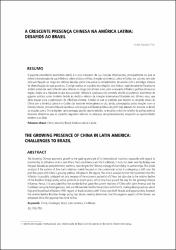Please use this identifier to cite or link to this item:
https://repositorio.ipea.gov.br/handle/11058/6473Full metadata record
| DC Field | Value | Language |
|---|---|---|
| dc.contributor.author | Pini, André Mendes | - |
| dc.coverage.spatial | China | pt_BR |
| dc.coverage.spatial | América Latina | pt_BR |
| dc.date.accessioned | 2016-05-23T15:13:49Z | - |
| dc.date.available | 2016-05-23T15:13:49Z | - |
| dc.date.issued | 2015-12 | - |
| dc.identifier.uri | http://repositorio.ipea.gov.br/handle/11058/6473 | - |
| dc.description.abstract | O pujante crescimento econômico chinês é o eixo norteador de sua inserção internacional, principalmente no que se refere à manutenção de sua influência sobre a Ásia e a África. A região da América Latina e Caribe, por sua vez, tem sido vista por Pequim ao longo das últimas décadas como uma parceira complementar, de acordo com a estratégia chinesa de diversificação de suas parcerias. O artigo analisa se o padrão das relações sino-latinas, majoritariamente focadas no âmbito comercial, vem sofrendo uma inflexão ao longo dos últimos anos, com a crescente influência política chinesa na região. Avalia-se a hipótese de que essa possível inflexão é catalisada não somente devido ao potencial econômico do gigante asiático, como também devido ao declínio relativo da inserção internacional brasileira nos últimos anos, que abriu espaço para a penetração da influência chinesa. Conclui-se que os padrões que balizam as relações atuais da China com a América Latina e o Caribe são bastante heterogêneas e são, ainda, sobrepujadas pelas relações com os Estados Unidos, tornando Pequim cautelosa com relação a inflexões políticas de perfil mais elevado. No tocante ao Brasil, as relações com a China impõem tanto ameaças quanto oportunidades, no entanto, o declínio relativo da política externa brasileira determina que os aspectos negativos relativos às ameaças são potencializados, enquanto as oportunidades tendem a se diluir. | pt_BR |
| dc.language.iso | pt-BR | pt_BR |
| dc.publisher | Instituto de Pesquisa Econômica Aplicada (Ipea) | pt_BR |
| dc.title | A Crescente presença chinesa na América Latina : desafios ao Brasil | pt_BR |
| dc.title.alternative | The Growing presence of China in Latin America : challenges to Brazil | pt_BR |
| dc.type | Boletim de Economia e Política Internacional - Artigos | pt_BR |
| dc.rights.holder | Instituto de Pesquisa Econômica Aplicada (Ipea) | pt_BR |
| dc.source.urlsource | http://www.ipea.gov.br | pt_BR |
| dc.location.country | BR | pt_BR |
| dc.description.physical | p. 21-31 | pt_BR |
| dc.subject.vcipea | IPEA::Condições Econômicas. Pesquisa Econômica. Sistemas Econômicos::Condições Econômicas::Crescimento Econômico::Crescimento Econômico | pt_BR |
| dc.subject.vcipea | IPEA::Cooperação Internacional. Relações Internacionais::Relações Internacionais::Tipos de Relações Internacionais::Relações Internacionais | pt_BR |
| dc.rights.license | É permitida a reprodução deste texto e dos dados nele contidos, desde que citada a fonte. Reproduções para fins comerciais são proibidas. | pt_BR |
| dc.subject.keyword | China | pt_BR |
| dc.subject.keyword | Desafios | pt_BR |
| dc.subject.keyword | América Latina | pt_BR |
| dc.subject.keyword | Caribe | pt_BR |
| dc.relation.references | http://repositorio.ipea.gov.br/handle/11058/6471 | pt_BR |
| ipea.description.additionalinformation | Artigo publicado em: Boletim de Economia e Política Internacional (BEPI): n. 21, set/dez. 2015 | pt_BR |
| ipea.description.additionalinformation | Possui referências bibliográficas | pt_BR |
| ipea.access.type | Acesso Aberto | pt_BR |
| ipea.rights.type | Licença Comum | pt_BR |
| ipea.englishdescription.abstract | The booming Chinese economic growth is the guiding principle of its international insertion, especially with regard to maintaining its influence on Asia and Africa. The Latin America and the Caribbean, in turn, has been seen by Beijing over the past decades as complementary partners, according to the Chinese strategy of diversifying its partnerships. This article analyzes if the pattern of Sino-Latin relations mainly focused on the commercial sector is undergoing a shift over the past few years with China’s growing political influence in the region. The article assesses further the hypothesis that this inflection is possibly catalyzed not only because of the economic potential of China, but also due to the relative decline of the Brazilian foreign policy active patterns in recent years, which may have paved the way for the growing Chinese influence. Hence, it is concluded that the standards that guide the current relations of China with Latin America and the Caribbean are quite heterogeneous, and are still overwhelmed by the relations with the US, making Beijing cautious about high profile political inflections. With regard to Brazil, relations with China pose both threats and opportunities, however the relative decline Brazilian foreign policy has shown recently determines that the negative aspects of the threats are enhanced while the opportunities tend to blur. | pt_BR |
| ipea.researchfields | Inserção Internacional Soberana | pt_BR |
| ipea.classification | Comércio Internacional | pt_BR |
| ipea.classification | Economia. Desenvolvimento Econômico | pt_BR |
| ipea.classification | Relações Internacionais | pt_BR |
| Appears in Collections: | Economia. Desenvolvimento Econômico: Artigos | |
Files in This Item:
| File | Description | Size | Format | |
|---|---|---|---|---|
| BEPI_n21_Crescente.pdf | 105.81 kB | Adobe PDF |  View/Open |
Items in DSpace are protected by copyright, with all rights reserved, unless otherwise indicated.

